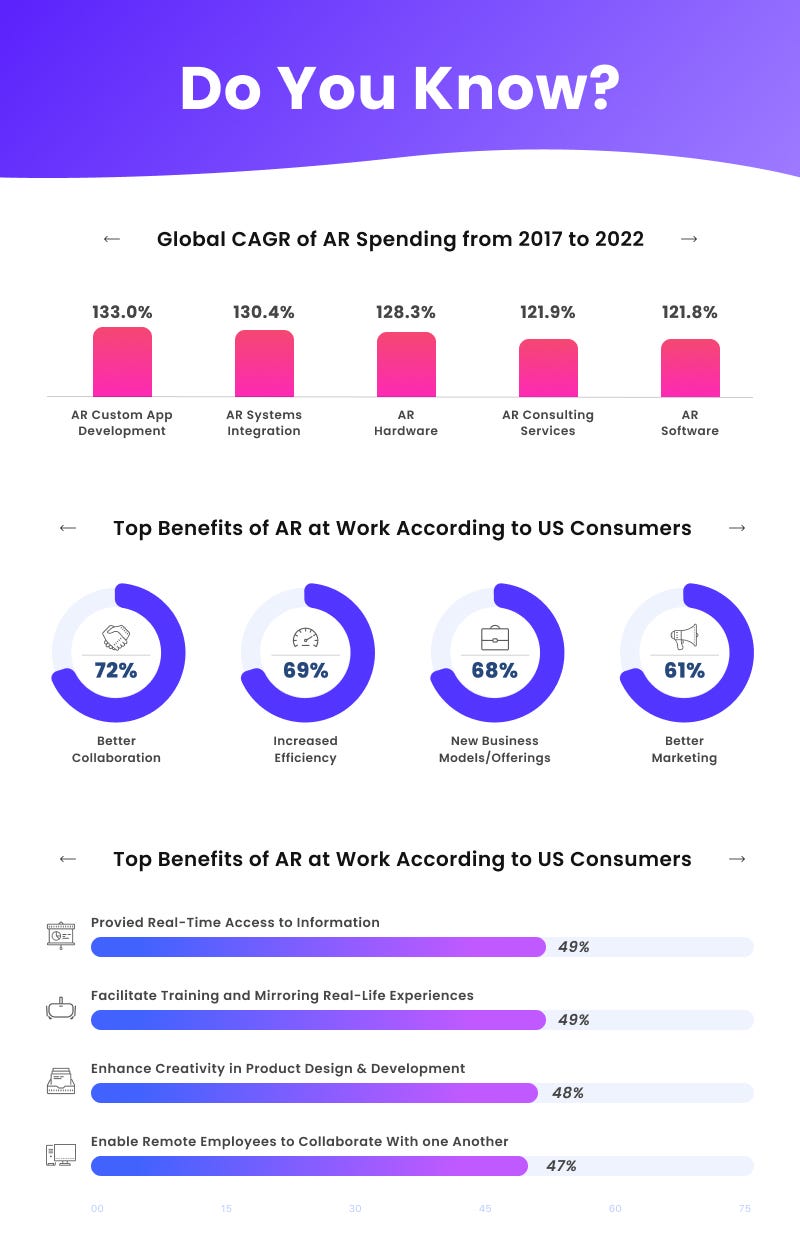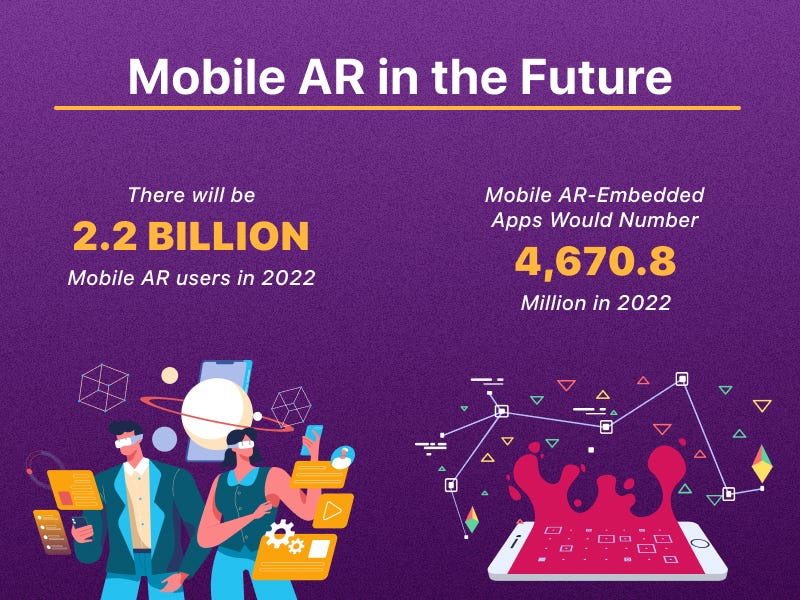Augmented Reality is an emerging technology that takes the real world and integrates with graphics, images, & sounds in order to create another dimension of experience. AR has been around since the early 2000s. But recently, this technology reached a level of maturity where it is poised to make significant impacts on society.
The future of Augmented Reality is coming, and it’s not just for entertainment anymore. Businesses are taking advantage of AR by developing software. AR-based software helps businesses increase efficiency in their daily operations — all while having more engaging experiences with customers!
As you consider investing in AR technology for your business, it’s important to understand what the top Augmented Reality trends will be in 2024, so you can get ahead of the curve.
Here you go with the top Augmented Reality Trends!

10 Augmented Reality Trends, Issues & Challenges
Here view the top Augmented Reality Trends 2022 on which you can work to gain profit in your business. Moreover, with the help of Augmented Reality developers, you make effective use of this technology.
1. AR-Enabled Shopping Experience
In July 2016, eBay launched a pilot program that lets iOS & Android devices users scan real items with their cameras to receive price information.
At first blush, Augmented Reality (AR) technology may seem like it’s the best fit for entertainment or game purposes. However, AR is making significant headway in other industries as well, including ecommerce and retail.
Thanks to IM(Information modeling), brands can now use AR to put an AR lens over physical products that customers can view from their mobile devices.
Moreover, this technological innovation allows customers to visualize which item will look good in their home before they make a purchase.
Retailers are thus able to engage consumers in new ways — and boost sales along the way.
But everything all the time cannot be perfect in the same way there are a few issues & challenges that may occur with AR-Enabled Shopping Experiences such as –
– How long will it take shoppers to become comfortable using them?
– Could a consumer inadvertently buy something because he/she thought they had tried it on through an app?
– What happens if multiple retailers offer similar products?
Whether we’re talking about cosmetics, clothing, or any other thing — experience always comes first for both B2C and B2B sellers.
Explore the top augmented reality trends shaping the future.
2. Team Collaboration Using AR
In recent research, it has been seen that currently, AR technology is acting like an advantage in team collaboration projects.
When comparing to face-to-face meetings, one of the major issues while doing meetings on skype is distance & not communicating same time. But using AR with video conferencing makes it easy for people to show required things or do work together remotely.
This collaboration can happen between different project sites, remote offices, or even across continents. Some other benefits of using Augmented Reality are cutting out external support costs such as travel expenses.
Moreover, it saves time because it eliminates traveling to meet each other. Furthermore, 3D models improve communication quality by making conversations more interactive and efficient.
Another advantage of AR is merging several mediums like print and web content which have a richer design experience compared to traditional websites.
Challenges occur in Team Collaboration Using AR due to its accessibility factor, as you need to purchase and install AR applications individually.
While discussing possibilities, we ought to consider obstacles that might come up on using Augmented Reality everywhere.
For example, although many companies are trying their best to educate the masses about Augmented Reality, still the majority of them don’t know about it yet.
Hence, without any knowledge, how would these devices be used? Another issue related to data security; privacy policy breach could cause an issue if someone tries to read sensitive data from your phone without your permission.
Also Read: Augmented Reality: A Comprehensive Guide to Its Use-Cases and Importance
3. Advancements in AR Hardware
There are many advancements that reiterate performance on mobile devices. While smartphones have led to great advancements with AR in recent years, other new hardware improvements are pushing further possibilities for AR.
One of these is computer vision. It detects objects (e.g., walls) while inside a building. With regard to smartphones, a few new releases from leading companies like Apple & Google may offer even better performance than before.
This can potentially lead to greater popularity of AR apps among consumers as well as additional developer interest for making those apps more engaging for users.
Of course, there are still some challenges ahead. In terms of advancement potential, one key issue to consider is battery life. Battery life remains one of the biggest drawbacks when it comes to AR on smartphones because most smartphone batteries do not last long enough for continuous use.
As battery power decreases over time, developers will need to find ways around frequent charging times so users don’t lose interest in using their phones for extended periods of time.
Also Read: How Augmented Reality Will Impact Businesses
4. WebAR
WebAR is a technology that extends a digital experience beyond a desktop or mobile screen by adding context to it. While WebVR takes content from your screen into virtual Reality, WebAR presents information about where you are so you can make better decisions about what to do next.
An AR overlay isn’t real — any sensory input can improve your experience. This could include audio cues that help guide you through a new city or haptic feedback when interacting with an interface.
While some AR displays create their own unique virtual world — like Snapchat filters on a smartphone camera — others integrate with real-world scenes to provide additional data points.
For example, a user might see how deep they are underwater as they swim in Hawaii. These experiences rely heavily on GPS to determine location and place markers in physical space; GPS isn’t always 100% accurate, however, which creates some challenges around making these apps work consistently across multiple devices and locations.
5. Avatars on the Rise
Avatars are becoming more common in new places, such as messaging apps.
WeChat, one of China’s most popular chat platforms, includes a feature that allows users to add various animated avatars — cartoonish dragons, even unlockable avatars that take selfies.
This trend is just getting started with a huge potential for growth throughout 2018 & beyond as more platforms support AR use cases in apps across industries.
Here’s why it matters:
The larger your audience, the higher chance you have to encourage repeat traffic that sticks around long-term.
If someone interacts with an avatar at a concert or when they stop in at your local coffee shop every morning before work, they feel like they know someone personally — making them more likely to keep up their habit than customers who visit without some kind of personal connection.
In turn, they become much more likely to become returning customers or patrons looking for ways to engage your brand on social media or through other channels.
It also helps create experiences people share online — something brands are always eager to do because it lets their customers do part of their job advertising for them!
6. AR on Mobile Devices

The world around us is changing at a lightning pace. Modern technology has brought in so many changes that it is almost impossible to keep up with all of them.
The new trend among smartphone users is none other than Augmented Reality (AR). Thanks to AR, we are able to interact with our surroundings in a whole new way.
You can add virtual objects into your surroundings or remove real ones; you can play games with your friends over long distances — even if they aren’t in front of their screens at exactly that moment. But while everything seems perfect now, the challenges ahead are still an issue. It can address before Augmented Reality can become mainstream.
Explore the top augmented reality trends now.
Let’s take a look at some of them right now.
First off, there’s an issue of app safety: an average user downloads more than 50 apps per month. With thousands available in each category of mobile applications, quality control can easily slip through.
It is estimated that over 90% of iOS apps have critical bugs & vulnerabilities which enable attackers to steal sensitive data like personal photos, credit card numbers, etc.
Secondly, developing AR projects requires both money and technical knowledge. Moreover, tools often cost hundreds or thousands of dollars just for one project license.
And developers usually also require additional programming knowledge, which may prevent customers from bringing their ideas to life.
If you are thinking of forming an AR-based mobile app for your business vertical, Hire Augmented Reality app developers working in the reliable Augmented Reality company (ValueCoders). By doing this, you will be able to get innovative solutions matching your key requirements.
7. Eye-Tracking & Facial Expressions
Since AR & VR depend on your eyes to render content, it’s essential that eye-tracking data is incorporated into their experiences. Taking it a step further — it is easy to record facial expressions and map virtual characters.
The result would be a closer simulation of real-life interactions that wouldn’t rely solely on hand gestures or speech recognition to dictate an experience. That could drastically reduce costs as companies don’t have to develop new sensors or cameras specifically for these technologies.
They simply have to integrate existing technology to take advantage of these additional services. Per observation of experts, these enhancements will be a central attraction over time since they will enrich experiences by bringing them one step closer to Reality.
While there aren’t any significant issues currently with facial tracking & emotion detection, there are numerous challenges faced when incorporating them into an immersive environment.
Moreover, you may face challenges related to Eye-Tracking & Facial Expressions while developing applications/services in an Augmented Reality environment. You need to work on it properly to ensure the eradication of certain technical problems like incorrect positioning, bad quality, etc.
Make sure to keep these things in mind while integrating AR technology: The app is ready for real-world testing such as lighting conditions, troubleshooting, etc.
Related Read: Top 10 Advanced Augmented Reality Tools To SKYROCKET Business
8. AR in Gaming
The AR gaming industry predicts seeing a 152.7% CAGR by 2023.
Augmented Reality (AR) is gaining popularity among mobile gamers due to its stunning visuals and immersive 3D experience. As per a survey conducted by Kzero-Alpine, 40% of users of mobile gaming devices are ready to pay for AR games.
There is no doubt that AR will also revolutionize the gaming industry as it will make games more interactive with vivid graphics & a 3D experience.
This report deals with trends driving the AR gaming market on smartphone devices across various regions, including North America, Europe, and Asia regions.
It also presents a competitive landscape of market players involved in creating AR-based games, providing various types of content on their platforms at affordable prices. You may also face challenges using AR-based games if you have low storage space available on your device.
An average AR game requires storage space between 100MB and 1GB. Another problem you might face while playing an AR game is battery drain due to heavy resource consumption from a powerful processor, high-end RAM units, high-resolution display screens, etc.
9. AR In Healthcare
Healthcare is rapidly adopting Augmented Reality (AR) technology. Many hospitals are using apps to visualize patient data overlaid on objects in real-world locations, like MRI scans & ultrasound images.
The idea behind these apps is that doctors can better understand difficult-to-grasp medical information by placing it in a familiar setting. In addition to allowing doctors to visualize patient data, many hospitals are turning to AR for diagnostic purposes as well.
This technology allows doctors to identify maladies through enhanced imagery of real-world objects. E.g., Doctors can see an x-ray image overlaying onto a live video feed from a chest X-ray machine during an examination.
Some healthcare organizations even use AR applications to simulate procedures for students before they perform surgery or administer care.
However, there are several challenges facing healthcare providers in their adoption of AR tech. For example, many companies have found difficulty moving beyond simulations into actual treatments.
62% of Americans consider AR is most valuable to the healthcare industry.
10. AR-Powered Driving
Technology-powered Augmented Reality (AR) is turning heads by taking experiences to a new level. Currently, it is leading in giving immersive driving experience which can employ for multiple practical purposes like information visualization.
AR glasses will enable drivers to avoid bad roads take smart steps on routes that are less populated or crowded. It also enables them to identify traffic jams or alter routes for a better drive.
The same technology may soon become part of car displays for improving safety features like collision detection & auto-braking systems etc.
However, using AR-Powered Driving, you may also face challenges, including focus, time & data storage issues to use these applications.
Explore the game-changing trends in augmented reality today.
How Will Augmented Reality Trends Change the Business Landscape?
Augmented Reality (AR) has been making headlines recently. It’s becoming prominent in our daily lives with devices like Google Glass, Snapchat filters on iOS phones, and more!
AR is a way of enhancing one’s perception of real-world surroundings with computer graphics such as sound, video, or graphics.
Wearable technology is becoming more popular each day. Not just smartwatches like Apple Watch or fitness trackers — there are opportunities for businesses to create apps that can use AR capabilities for mapping systems or GPS.
There are also potential commercial uses for AR, like advertising. It is resulting in some investors being willing to put money into firms working on AR platforms.
This type of software offers many possibilities that could drastically change how we do certain things online and off. In this way, AR is profiting businesses.
Also Read: How AR/VR Transforming Shopping Experience In Upcoming Years?
Conclusion
As Augmented Reality trends continue to evolve, businesses should prepare for the upcoming changes. With new technology comes new opportunities & challenges, & it will be interesting to see how businesses adapt in order to stay ahead of the competition. Are you ready to adopt AR trends?
Get connected with the excellent Augmented Reality development company (ValueCoders) to hire Augmented Reality developers. This will assist you in making efficient use of AR trends.






